Picture of Deer Like Animal Near Dripping Springs
Picture of Deer Like Animal Near Dripping Springs
Nature
10 Wildlife Species in The Texas Loma Country
We hate spam too, we'll never share your email address
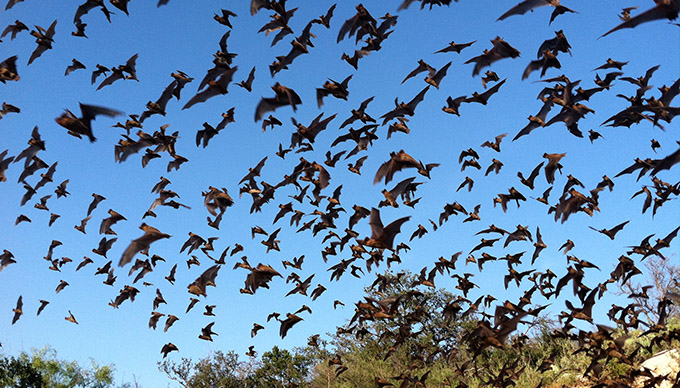
The ecologically diverse mural of the Hill Country is dwelling to native species, including several on the endangered list, which are not found anywhere else in the globe. Land stewardship programs, state parks and natural areas protect natural habitats and provide opportunities to view and acquire about our native wildlife.
Hither are 10 species you might come across in the Texas Hill land.
1. Guadalupe Bass, Micropterus treculii

Photo: Wikimedia Eatables
The Guadalupe bass, also known as black bass or Guadalupe spotted bass, is the official country fish of Texas. Information technology is really a member of the sunfish family unit and lives in small streams in parts of the Guadalupe, San Antonio, Colorado and Brazos Rivers. While small populations reside outside of the Edwards Plateau, this species does not live anywhere else on world.
Guadalupe bass are small, light-green in colour and practice not have distinguishable vertical confined like the smallmouth bass. They are adapted to small streams, but have a propensity for fast flowing water. This makes Guadalupe bass a popular sport fishing species.
2. White-tailed Deer, Odocoileus texanus
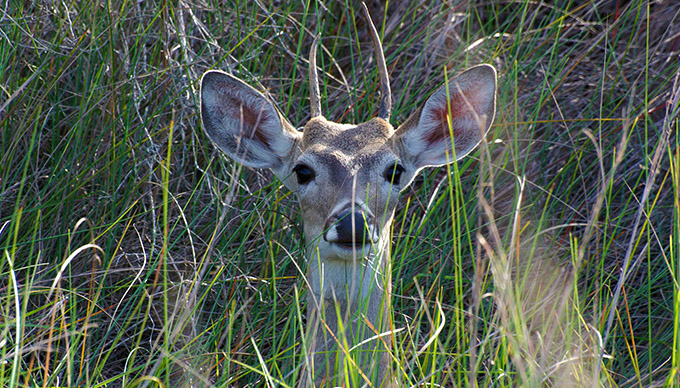
Photo: Flickr/Terry Ross
Texas has the largest white-tailed deer population in the country, with an estimated 3 to four million deer residing throughout the state. The deer prefer the wooded, brushy terrain of the Loma Country, and so in that location is an abundant population in the area. This habitat offers good cover and a multifariousness of food sources, such as twigs, plants, fruit and grass. When it comes to food, white-tailed deer brand no distinction betwixt wild wooded terrain and human being dwellings. They ofttimes enter yards in suburban areas and damage landscaping and gardens.
They are red-dark-brown in color during the summer months and grayish-brownish in winter. The tail is commonly held erect, particularly when fleeing, to show its white underside. Fawns have vivid white spots on their coats until they are about 6 months old. Bucks abound a new gear up of antlers every twelvemonth and shed the old ones when the breeding flavor is over between December and March.
3. Texas Map Turtle, Graptemys versa
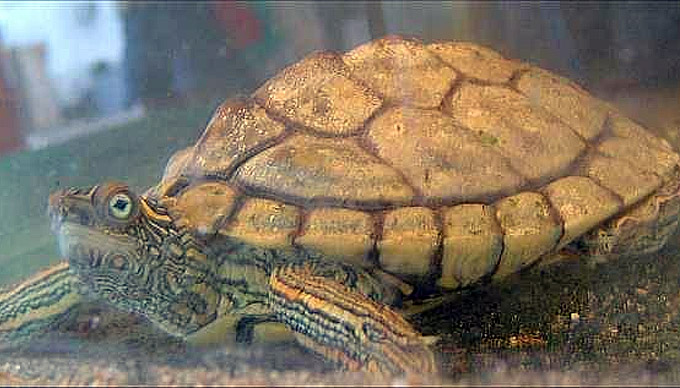
Photo: Wikimedia Commons
The Texas map turtle is truly unique to the Texas Hill Country. It is just establish in the Colorado River and its tributary streams within the Edwards Plateau. Information technology is the smallest species of the map turtle family unit, only reaching up to vii inches in length, and females grow larger than males. The temperature of the turtles' environs determines the gender of hatchlings. Lower temperatures produce males, and college temperatures produce females.
Texas map turtles are nighttime olive to brown in colour, with yellow-orange or orange line markings – resembling lines on a map – on its shell, head, limbs and tail. The underside of its head has iii yellowish or orange spots. They are strong swimmers, and you might catch a glimpse of them perched on a rock or tree trunk basking in the sun.
four. Mexican Free-tailed Bat, Tadarida brasiliensis

Photo: Flickr/U.South. Fish and Wildlife Service
The Mexican complimentary-tailed bat is the state flying mammal of Texas. Likewise known every bit Brazilian gratuitous-tailed bats, they primarily alive in caves in the Balcones Escarpment and the Edwards Plateau. However, they tin roost in any dark, dry space. They are famous for their habitat under the Congress Artery bridge in Austin, which attracts visitors from all over the earth. Every summertime evening, hordes of visitors line the bridge to grab a glimpse of the bat colony as it flies out en masse for their nightly feeding. The bats' nutrition is mainly comprised of moths, crickets, grasshoppers and mosquitos.
These medium-sized bats take broad ears, large anxiety and half of their tail hangs free. Their fur is short, velvety and reddish to black in color. They can alive up to 11 years in the wild and migrate to Mexico, Central America and South America for the coldest wintertime months.
This bat is a known carrier of rabies, so exercise caution if y'all ever encounter one.
five. Texas Bullheaded Salamander, Eurycea rathbuni
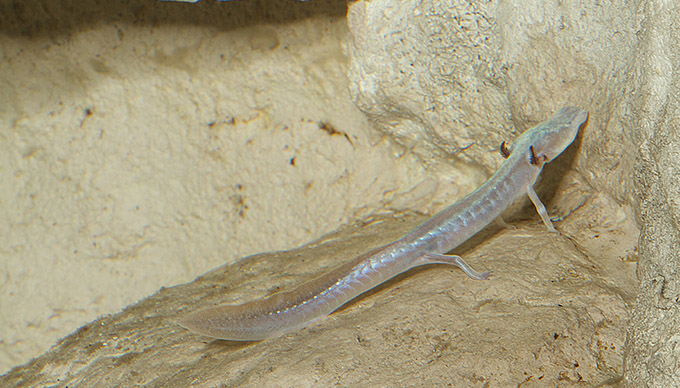
Photo: Flickr/Brian Gratwicke
The Texas blind salamander lives in the h2o-filled caves of the Edwards Aquifer in Hays Canton. Since information technology is adapted to live in water hush-hush, it does not take eyes. Instead, it has two pocket-size black dots under the pare where the eyes would be. Information technology has very little peel pigment and red external gills. The salamander hunts by sensing h2o pressure waves created by the movement of tiny snails, shrimp and other aquatic invertebrates.
Pollution and overuse of water in the Edwards Aquifer threaten the salamander'due south survival. It is currently on the Texas and U.S. endangered species lists.
6. San Marcos Salamander, Eurycea nana
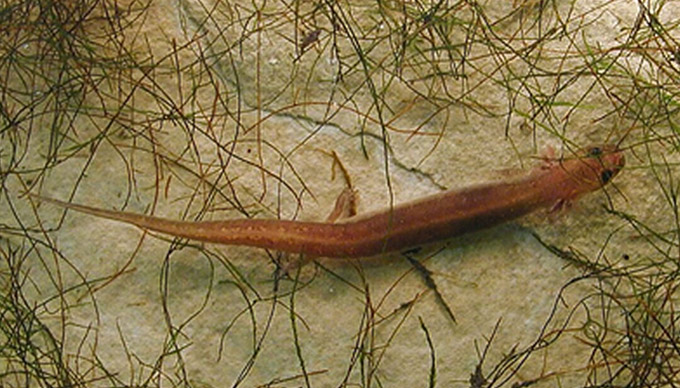
Photo: Wikimedia Commons
This amphibian resides only in the articulate, flowing bound water of the upper San Marcos River in Hays Canton. The salamander is small, slender and dark ruby-red-brownish in color, which matches the colour of the moss and algae in its natural habitat. Information technology feeds on tiny crustaceans, aquatic insects and snails.
Because it prefers cool, flowing water, the reduced flow of h2o from Hill Country springs threatens the survival of this species of salamander. It is currently on the Texas and U.S. threatened species list.
vii. Golden-cheeked warbler, Dendroica chrysoparia
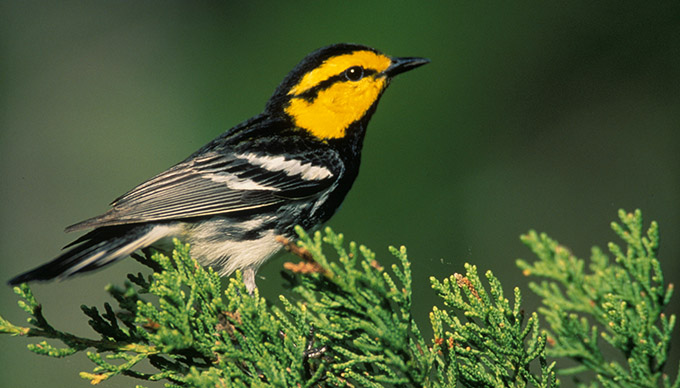
Photo: Wikimedia Commons
The Aureate-cheeked warbler nests only in the woodlands in the ravines and canyons of central Texas. They prefer alpine Ashe juniper, oak and other hardwood trees, using long strips of bawl, spider webs, grasses, cocoons, and creature fur to build their nests. The warblers drift to Texas in March to nest and raise their immature, then go out in July to spend the fall and winter months in Mexico and Cardinal America.
They are on the Texas and U.Southward. endangered species lists, some habitat areas were cleared to build houses and roadways or for farming purposes. Visitors to the Hill State can spot gilded-cheeked warblers at the numerous state parks in the area.
eight. Nine-banded Armadillo, Dasypus novemcinctus

Photo: Flickr/leppyone
The nine-banded armadillo is the land pocket-sized mammal of Texas and resides throughout most of the state. It is about the size of a cat, with a trunk length of fifteen to 17 inches and tail length of 14 to 16 inches. They usually weigh betwixt eight and 17 pounds and accept bony, scaled shells, which protects them from predators.
Armadillos are diggers. They dig burrows for shelter, and dig in soft soil for nutrient, such as grubs, insects and other invertebrates. They occasionally consume berries and bird eggs found shut to or on the ground.
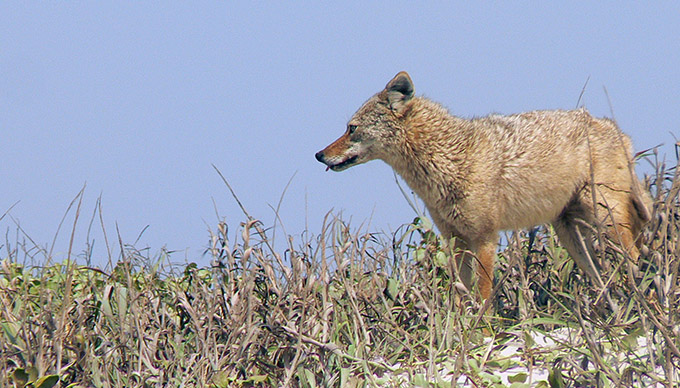
Photo: Flickr/Terry Ross
Coyotes are populous throughout the country of Texas. They are aggressive livestock predators, just they too offering protection to crops by controlling rodent and rabbit populations. Coyotes normally alive from x to 12 years and can adjust to almost whatever habitat, including the brushy, wooded terrain of the Hill Land. Some area residents have seen coyotes roaming around their suburban neighborhoods.
Coyotes are like in size to small German language shepherds, with long, slender legs, a bushy tail and big ears they hold erect. Their coats are usually gray or vitrify colored, and they weigh an average of 25 to 40 pounds. They are very intelligent, nocturnal and opportunistic. They will eat almost anything, including rabbits, rodents, insects, lizards, snakes, fruits and vegetables.
10. Blackness-capped Vireo, Vireo atricapilla
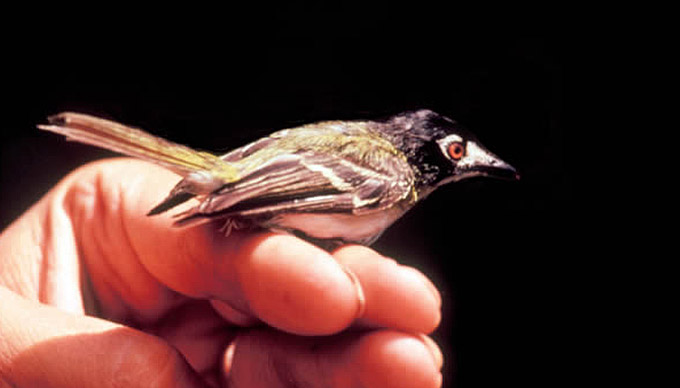
Photo: Wikimedia Eatables
Blackness-capped vireos nest in Texas, throughout the Edwards Plateau, Apr to July, and and so drift to the western coast of Mexico for the winter. They build cup-shaped nests in the fork of a co-operative in small shrubs similar shin oak or sumac. Vireos render to the aforementioned area to nest year after year.
These small birds only reach about four to five inches long and accept a lifespan of v to 6 years.
Blackness-capped Vireos are on the Texas and U.S. endangered species lists, because the low growing woody cover they need for nesting has been cleared or overgrazed by livestock and deer.
Picture of Deer Like Animal Near Dripping Springs
Source: https://texashillcountry.com/10-wildlife-species-in-the-texas-hill-country/



Comments
Post a Comment